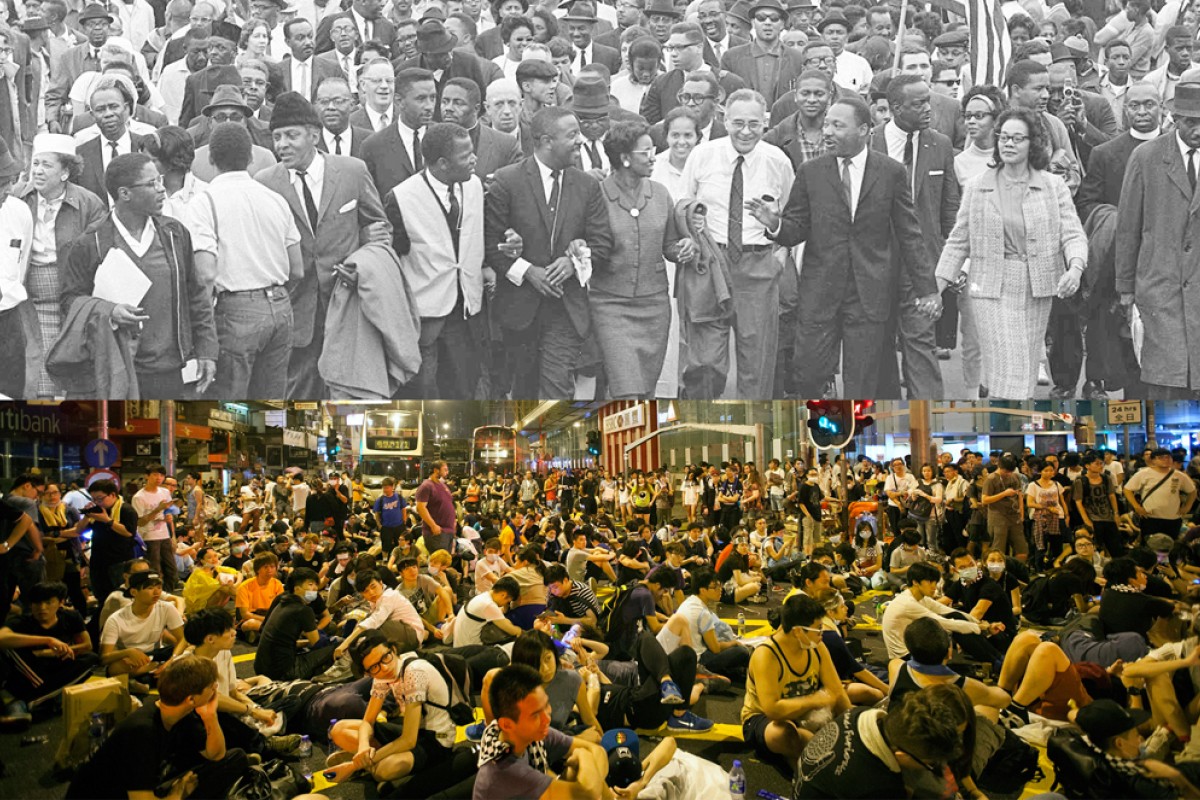
Today marks half a year since the start of Occupy Central. We look at how the protests compare to the events in the United States 49 years ago that inspired the movie Selma

With many scenes strikingly similar to last year’s Occupy Central protests, Hongkongers have no trouble relating to the film Selma, which was based on real events. After attending the charity premiere in Hong Kong on February 27, Benny Tai Yiu-ting, one of the pro-democracy leaders, posted on his Facebook page: “The experience of black Americans fighting for equal rights and of non-violent protests elsewhere might inspire Hong Kong on the long and difficult road to democracy.”
The people in Hong Kong long for the same things as those in Selma did: voting rights and democracy. But how similar are the two movements?
Back in 1965, a group of black Americans who wanted to exercise their constitutional right to vote in the United States joined three marches from Selma to the Alabama state capital of Montgomery.
The right to vote
Voting rights were granted to American citizens no matter their “race, colour, or previous condition of servitude” by the Fifth Amendment to the country’s Constitution long before, in 1765. But the black population was not satisfied with only having voting rights on paper, especially when they couldn't register to vote without harassment.
Similarly, Hongkongers are also granted the right to vote for their own chief executive. After the Handover in 1997, the central government promised that in 2017, the chief executive would be selected by universal suffrage for the first time.
However, as Beijing's top legislative body then decided to restrict the nominations for chief executive in 2017, pro-democracy protesters in Hong Kong took to the streets in September 2014. During the 79-day demonstration, the protesters asked for true universal suffrage and full democracy.
Unsatisfied with voting rights that only work on paper led to two different groups of protesters, in two different cities, and from two different eras, fighting for more. Another echo from the past is that, like in Selma, a tear gas attack motivated more citizens to join the protests.
Non-violent approach
Leaders for both movements insisted on non-violence and stuck to acts of civil disobedience, despite discontent among some of their own who wanted to fight violence with violence.
Meanwhile, the governments of both Alabama and Hong Kong spared no effort to criticise and oppose the movements.
Governor Wallace of Alabama denounced the marches as a threat to public safety, while Hong Kong's chief executive Leung Cheung-ying called the sit-ins occupying important areas of the city illegal and uncontrollable.
Despite some similarities, the two movements, which took place 49 years apart, definitely have their differences.
Officials’ reactions
Contrary to the wishes of the governor of Alabama, then US President Lyndon Johnson protected the protesters by sending military policemen and army troops to escort them on their last march on March 21 from Selma to Montgomery. Johnson tried to persuade Wallace to stop the state harassment of the protesters, and went on to push for the passage of the Voting Rights Act in the same year.
In Hong Kong, the central government sided with the Hong Kong government. State media Xinhua news agency reported the central government “fully agrees and firmly supports” the Hong Kong government and with the police force's decisions to maintain social order and safeguarding the rule of law.
A difference in leadership
The leaders of the Selma marches were members of several black American civil rights groups for common goals, which kept marchers from all over the country stay on the same page.
During the second march on March 9, 1965, Martin Luther King asked participants to turn around before they reached their destination and walk back, in an effort to obey a court order preventing them from completing the planned course. Though confused, marchers were convinced by King’s leadership, and trusted in his recommendation that they wait until the injunction was lifted before attempting another march.
Meanwhile in Hong Kong, protesters’ behaviour varied. Much of it may have been due to the open debates on where the movement was going, how to achieve protesters' goal, and who the leader was. Without a clear leader, the movement splintered.
Occupy Central suffered from ongoing shifts in leadership, starting with Occupy Central with Love and Peace and transferring to students from the Hong Kong Federation of Students and Scholarism, and moving between relatively conservative parties to more radical ones.
The marches in Selma became a landmark achievement in the landscape of US civil rights movement in the 1960s, and led to the Voting Rights Act being passed in 1965. What might come from last year's protests in Hong Kong remains to be seen.